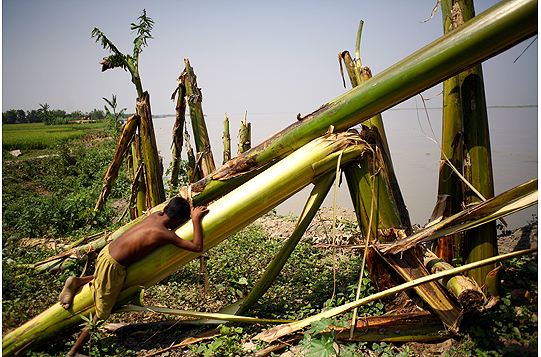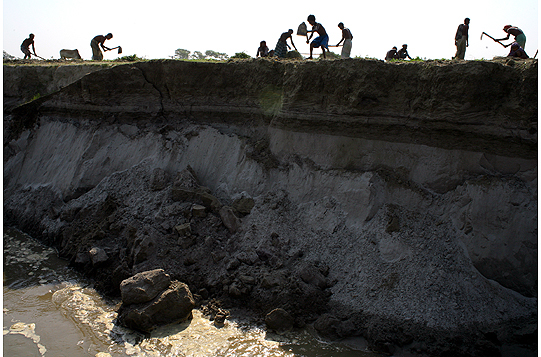WITH THE CONTINUANCE OF GLOBAL WARMING, BANGLADESH, AS ONE OF THE 10 COUNTRIES MOST VULNERABLE TO A RISE IN SEA LEVEL IN THE WORLD, IS BEING DRASTICALLY AFFECTED. THIS IS INDEED A CRUEL TWIST OF FATE, SINCE BANGLADESH, AS ONE OF THE POOREST COUNTRIES ON EARTH, HAS CONTRIBUTED VERY LITTLE TO GLOBAL WARMING. THIS PHOTO-ESSAY EXPLORES THE FATE OF THE ESTIMATED 6.5 MILLION PEOPLE WHO LIVE ON THE CHARS (LARGE SANDBANK RIVER ISLANDS THAT ONCE BELONGED TO THE MAINLAND) AND ASSOCIATED EROSION AREAS, IN A COUNTRY WHERE LAND IS THE REAL HUNGER: 80% OF ITS POPULATION IS RURAL, 60% LANDLESS.

A family walks by the edge of their char land, where the effects of river erosion can be clearly seen. Chilmari, 2007.

A boy checks the effects of river erosion on the mainland. Dewanganj, 2007.

A woman takes her cattle for grazing. Cattle is common in every char but it's rarely owned by the char-dwellers, who are too poor to afford more than a hand-to-mouth existance. Sariakandi, 2007.

A family works on their land, just a few feet away from the river, which is eroding the land day by day and will soon force the family to look for land somewhere else. Chilmari, 2007.

Bangladesh is the most densely populated country in the world (around 140 million), and land is a major source of conflict. The proportion of landless people has been increasing with nearly 50% of rural households functionally landless, which forces them to colonize very marginal areas including the chars. But even in the chars it is a major source of conflict. Chilmari, 2007.

A group of children check the effects of river erosion on the mainland. In the last 20 years, the rivers have been angrier. The Jamuna (whose banks are about the most erosion-prone places in the country) has swollen and changed its course drowning some charlands for ever and creating new ones. Disaster is no longer predictabe. Dewanganj, 2007.

Children follow the lesson as the teacher continues reading. Education is available in some of the older or bigger chars, although male adult literacy in Bangladesh is still around 50%, while 30% for female adults. Chilmari, 2007.

A man gives the finishing touches to his new house. He was recently forced to move to this new area on the same char because the river had destroyed his village. Only 40% of the char in the Jamuna river persists more than 6 years. It implies that char dwellers in 60% of the Jamuna chars have to migrate more than once within 6 years. It is not unusual for adults in the Jamuna region to have moved six to ten times in their lives. Chilmari, 2007.

Men take a local boat to go to the mainland market at sunset. Many char-dwellers go to the mainland markets once or twice a week for selling or purchasing different kinds of merchandise. Sariankandi, 2007.

The efects of the erosion rivers are causing in the char lands. Everytime a family has to move to a new village in the same char or in a different one, the process pushes them further into poverty. Chilmari, 2007.

Women work on their house's common area. Sariakandi, 2007.

Children plan by their village's riverbank. Dewanganj, 2007.

On the mainland, a woman dismantles her house before she builds it again on the roadside. The river is eroding the land day by day thus forcing thousands to move somewhere else, but land is scarce on the mainland and many are unable to find new land for agriculture. Erosion may turn a land-owning farmer into a landless day labourer. Chilmari, 2007.

A young girl and her mother stand in front of their house. Char-dwellers get ready for the monsoon season by placing their households on higher ground. Even this does not guarantee that the river will not be angrier and higher each time, therefore flooding not only the land but the houses to, forcing their owners to seek refuge on the mainland. Sariakandi, 2007.

Char-dwellers witness the destruction of their land caused by the Yamuna river. Behind them men are working on the crops as they hear the land literally disappearing. Dewanganj, 2007.

Men gather at a local teahouse in one of the river chars. While many chars are too poor or too new to offer such commodities, others have survived for several years and its inhabitants have opened up small shops or tea houses. Chilmari, 2007.

